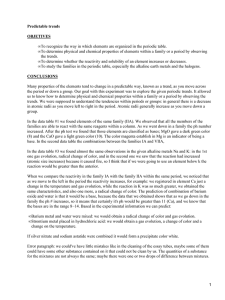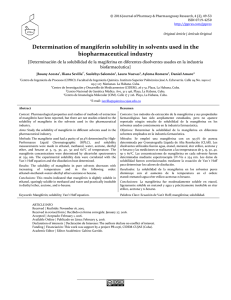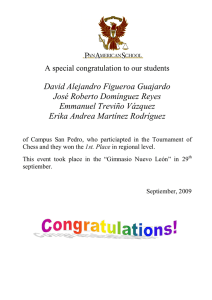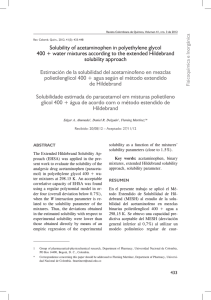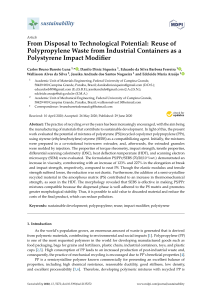Preferential solvation of acetaminophen in ethanol + water solvent
Anuncio
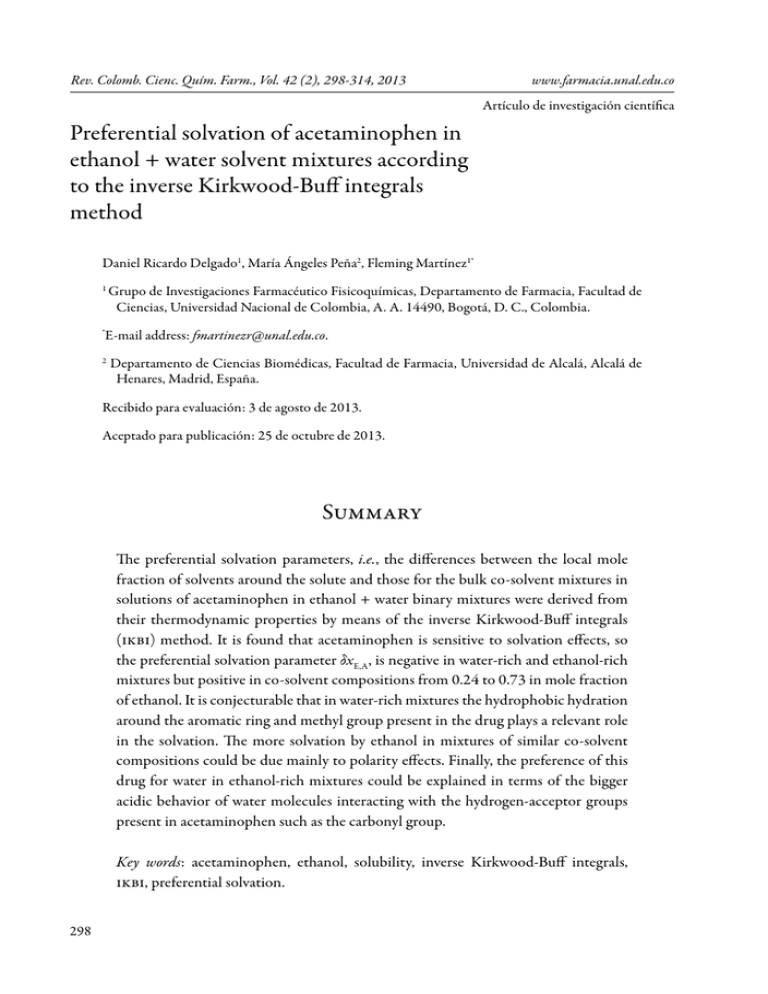
Rev. Colomb. Cienc. Quím. Farm., Vol. 42 (2), 298-314, 2013 www.farmacia.unal.edu.co Artículo de investigación científica Preferential solvation of acetaminophen in ethanol + water solvent mixtures according to the inverse Kirkwood-Buff integrals method Daniel Ricardo Delgado1, María Ángeles Peña2, Fleming Martínez1* 1 Grupo de Investigaciones Farmacéutico Fisicoquímicas, Departamento de Farmacia, Facultad de Ciencias, Universidad Nacional de Colombia, A. A. 14490, Bogotá, D. C., Colombia. E-mail address: fmartinezr@unal.edu.co. * 2 Departamento de Ciencias Biomédicas, Facultad de Farmacia, Universidad de Alcalá, Alcalá de Henares, Madrid, España. Recibido para evaluación: 3 de agosto de 2013. Aceptado para publicación: 25 de octubre de 2013. Summary The preferential solvation parameters, i.e., the differences between the local mole fraction of solvents around the solute and those for the bulk co-solvent mixtures in solutions of acetaminophen in ethanol + water binary mixtures were derived from their thermodynamic properties by means of the inverse Kirkwood-Buff integrals (ikbi) method. It is found that acetaminophen is sensitive to solvation effects, so the preferential solvation parameter δxE,A, is negative in water-rich and ethanol-rich mixtures but positive in co-solvent compositions from 0.24 to 0.73 in mole fraction of ethanol. It is conjecturable that in water-rich mixtures the hydrophobic hydration around the aromatic ring and methyl group present in the drug plays a relevant role in the solvation. The more solvation by ethanol in mixtures of similar co-solvent compositions could be due mainly to polarity effects. Finally, the preference of this drug for water in ethanol-rich mixtures could be explained in terms of the bigger acidic behavior of water molecules interacting with the hydrogen-acceptor groups present in acetaminophen such as the carbonyl group. Key words: acetaminophen, ethanol, solubility, inverse Kirkwood-Buff integrals, ikbi, preferential solvation. 298 Preferential solvation of acetaminophen in ethanol + water mixtures Resumen Solvatación preferencial del acetaminofeno en mezclas cosolventes etanol + agua según el método de las integrales inversas de Kirkwood-Buff Con base en algunas propiedades termodinámicas clásicas de solución en este trabajo, se calcularon los parámetros de solvatación preferencial del acetaminofeno (δxE,A) en mezclas etanol + agua mediante las integrales inversas de Kirkwood-Buff. Los parámetros δxE,A corresponden a las diferencias entre las fracciones molares locales de los solventes alrededor del soluto y en el grueso de la solución. Con base en estos valores, se puede observar que este fármaco es altamente sensible a efectos específicos de solvatación que varían según la composición cosolvente. Así, los valores de δxE,A son negativos en mezclas ricas en agua y en mezclas ricas en etanol, pero positivos en composiciones desde 0,24 hasta 0,73 en fracción molar de etanol. Es probable que la hidratación hidrofóbica alrededor del anillo aromático y el grupo metilo del acetaminofeno pueda tener un papel relevante en la solvatación del fármaco en mezclas ricas de agua. En mezclas de composición intermedia, la mayor solvatación por las moléculas de etanol podría deberse principalmente a efectos de polaridad. Finalmente, la preferencia que este fármaco manifiesta por el agua en mezclas ricas en etanol podría explicarse en términos del mayor comportamiento ácido de las moléculas del agua, que estarían interactuando con los grupos aceptores de hidrógeno presentes en el acetaminofeno, tales como el carbonilo. Palabras clave: acetaminofeno, etanol, solubilidad, integrales inversas de KirkwoodBuff, ikbi, solvatación preferencial. Introduction Acetaminophen (A or ACP, N-(4-hydroxyphenyl)ethenamide, CAS 103-90-2, Figure 1), also known as paracetamol, is a classical drug commonly used in therapeutics because of its analgesic and antipyretic effects. This drug is specially indicated in the treatment of several minor diseases presented by pediatric patients [1, 2]. Solubility of drugs in co-solvent mixtures knowledge is very important for pharmaceutical scientists involved in several development stages such as drug purification and design of liquid medicines [3]. Although co-solvency has been employed in pharmacy for centuries it is recently that the mechanisms involved to increase or decrease drugs 299 Delgado, Peña, Martínez solubility have been approached from a physicochemical point of view [4]. In this way, several thermodynamic works have been published based on the enthalpic and entropic contributions to the Gibbs energy of solution, and in some specific cases, the solvation of analgesic drugs in aqueous alcoholic mixtures has been analyzed from thermodynamic quantities of the drug sublimation [2, 5-7]. Nevertheless, the drug preferential solvation, i.e. the co-solvent specific composition around the drug molecules has not been completely studied for analgesic drugs [8]. Therefore, the main goal of this paper is to evaluate the preferential solvation of acetaminophen in ethanol + water co-solvent mixtures, based on thermodynamic definitions. Thus this work is a continuation of the ones presented previously in the literature for some analgesic drugs in co-solvent mixtures [9-11]. NH-CO-CH3 OH Figure 1. Molecular structure of acetaminophen The inverse Kirkwood-Buff integral (ikbi) is a powerful tool for evaluating the preferential solvation of nonelectrolytes in solvent mixtures, describing the local compositions around a solute with respect to the different components present in the solvent mixture [12-14]. In the present case, this treatment depends on the values of the standard molar Gibbs energies of transfer of the solute acetaminophen from neat water to the ethanol + water solvent mixtures and the excess molar Gibbs energy of mixing for the co-solvent binary mixtures. As has been indicated previously, this treatment is very important in pharmaceutical sciences to understand the molecular interactions solute-solvent because most of the solubility studies developed have been directed towards correlating or modeling the solubilities and possibly predicting them from the solubilities in the neat solvents, but not to analyze the local environment around the drug molecules describing the local fraction of the solvent components (E or W) in the surrounding of solute (A) [15, 16]. 300 Preferential solvation of acetaminophen in ethanol + water mixtures In this paper the ikbi approach is applied to evaluate the preferential solvation of the acetaminophen in the binary mixtures conformed by ethanol (E or EtOH) and water (W). The results are expressed in terms of the preferential solvation parameter δxE,A of the solute by the two solvent components. Another well-known thermodynamic method used to calculate δxE,A is the one proposed by Marcus so-called Quasi-lattice quasi-chemical (qlqc) approach [15, 16]. This method is simpler to use than ikbi method but it is useful when the maximum solubility is found in the co-solvent under consideration. This is not the case with acetaminophen in ethanol + water mixtures where the maximum drug solubility is found in mixtures with 0.90 in mass fraction of ethanol [5]. Theoretical The KBIs (Kirkwood-Buff integrals, Gi, A) are given by the following expression: rcor Gi ,A = ∫ ( g i ,A − 1)4 r 2 dr 0 (1) Here gi,A is the pair correlation function for the molecules of the solvent i in the ethanol + water mixtures around the solute acetaminophen, r the distance between the centers of the molecules of acetaminophen and ethanol or water, and rcor is a correlation distance for which gi,A (r > rcor) ≈ 1. Thus, for all distances r > rcor up to infinite, the value of the integral is essentially zero. Therefore, the results are expressed in terms of the preferential solvation parameter δxi,A for the solute in solution by the component solvents ethanol and water [17]. For ethanol (E) this parameter is defined as: L x E,A = x E,A − x E = − x W,A (2) L Where xE is the mole fraction of ethanol in the bulk solvent mixture and x E,A is the local mole fraction of ethanol in the environment near to the drug. If x E,A > 0 then the solute acetaminophen is preferentially solvated by ethanol; on the contrary, if it is < 0 the drug is preferentially solvated by water, within the correlation volume, 3 Vcor = ( 4 / 3) rcor , and the bulk mole fraction of ethanol, xE. Values of x E,A are obtainable from those of GE,A, and these in turn, from thermodynamic data of the co-solvent mixtures with the solute dissolved on it, as shown below [15]. Algebraic manipulation of the basic expressions presented by Newman [17] leads to expressions for the Kirkwood-Buff integrals (in cm3 mol–1) for the individual solvent 301 Delgado, Peña, Martínez components in terms of some thermodynamic quantities as shown in equations (3) and (4) [12, 15, 16]: GE,A = RT kT − VA + x WVW D / Q GW,A = RT kT − VA + x EVE D / Q (3) (4) Where kT is the isothermal compressibility of the ethanol + water solvent mixtures (in GPa–1), VE and VW are the partial molar volumes of the solvents in the mixtures (in cm3 mol–1), similarly, VA is the partial molar volume of solute in these mixtures (in cm3 mol–1). The function D is the derivative of the standard molar Gibbs energies of transfer of the drug (from neat water to ethanol + water mixtures) with respect to the solvent composition (in kJ mol−1, as also is RT) and the function Q involves the second derivative of the excess molar Gibbs energy of mixing of the two solvents (GEExc + W ) with −1 respect to the water proportion in the mixtures (also in kJ mol ) [15, 16, 18]: ∂∆ trG(0A,W → E + W ) D= ∂x E T,p (5) Exc ∂ 2GE,W Q = RT − x E x W 2 ∂x W (6) T,p Because the dependence of kT on composition is not known for a lot of the systems investigated and because of the small contribution of RT kT to the ikbi the dependence of kT on composition could be approximated by considering additive behavior according to the equation (7) [19]: n kT ,mix = ∑ x i kT0 , i (7) Where xi is the mole fraction of component i in the mixture and kT0 , i is the isothermal compressibility of the pure component i. i =1 Ben-Naim [12] showed that the preferential solvation parameter can be calculated from the Kirkwood-Buff integrals as follows: x E,A = 302 x E x W (GE,A − GW,A ) x EGE,A + x WGW,A + Vcor (8) Preferential solvation of acetaminophen in ethanol + water mixtures The correlation volume, Vcor, is obtained by means of the following expression proposed by Marcus [8, 16]: ( ( L L Vcor = 2522.5 rA + 0.1363 x E,A VE + x W,A VW ) 1/3 − 0.085 ) 3 (9) Where rA is the radius of the solute (in nm), calculated as: 3 ⋅1021VA rA = 4 N 1/3 (10) Where NAv is the Avogadro number. However, the definitive correlation volume requires iteration, because it depends on the local mole fractions. This iteration is done L until a non-variant value of Vcor by replacing x E,A in the equation (2) to calculate x E,A is obtained. Av Results and discussion The solubility of acetaminophen in ethanol + water mixtures (Table 1) was taken from Jiménez and Martínez [5]. Standard molar Gibbs energy of transfer of this drug from neat water to ethanol + water mixtures is calculated and correlated to regular quartic polynomials from the drug solubility data by using equation (11). This degree of polynomials was chosen based on some significant statistical parameters as the respective determination coefficients and residual analyses (values not shown here). In this way, decimal places in the quantities reported in almost all the tables along the document were defined as has usually been done in some previous researches [9-11]. Otherwise, Figure 2 shows the Gibbs energy of transfer behavior at 298.15 K whereas Table 2 show the behavior at all the temperatures studied. Polynomials coefficients are shown in Table 3. x A,W 0 = a + bx E + cx E2 + dx E3 + ex E4 ∆ trGA,W → E + W = RT ln x A,E + W (11) Table 1. Mole fraction solubility (xA)a of acetaminophen at several temperatures. xEtOH b 293.15 K 298.15 K 303.15 K 308.15 K 313.15 K 0.0000 1.52 E-03 1.85 E-03 2.09 E-03 2.56 E-03 3.15 E-03 0.0417 2.43 E-03 3.27 E-03 3.82 E-03 4.42 E-03 5.70 E-03 0.0891 4.70 E-03 6.87 E-03 7.51 E-03 8.70 E-03 1.07 E-02 303 Delgado, Peña, Martínez Table 1. Mole fraction solubility (xA)a of acetaminophen at several temperatures (continuation). xEtOH b 293.15 K 298.15 K 303.15 K 308.15 K 313.15 K 0.1436 1.05 E-02 1.32 E-02 1.54 E-02 1.81 E-02 2.18 E-02 0.2068 1.87 E-02 2.22 E-02 2.54 E-02 2.91 E-02 3.42 E-02 0.2812 3.02 E-02 3.47 E-02 3.94 E-02 4.45 E-02 5.21 E-02 0.3698 4.19 E-02 4.55 E-02 5.20 E-02 5.75 E-02 6.74 E-02 0.4772 5.24 E-02 5.72 E-02 6.25 E-02 6.88 E-02 7.91 E-02 0.6101 6.00 E-02 6.58 E-02 7.10 E-02 7.81 E-02 8.88 E-02 0.7788 6.25 E-02 6.61 E-02 7.41 E-02 8.09 E-02 9.13 E-02 1.0000 5.04 E-02 5.46 E-02 6.20 E-02 6.68 E-02 7.05 E-02 a Data from Ref. [5]. b xEtOH is the mole fraction of ethanol in the ethanol + water co-solvent mixtures free of acetaminophen. 0,00 -1,00 -2,00 ∆trGº/kJ mol-1 -3,00 -4,00 -5,00 -6,00 -7,00 -8,00 -9,00 -10,00 0,00 0,20 0,40 0,60 0,80 1,00 xEtOH Figure 2. Gibbs energy of transfer of acetaminophen from neat water to ethanol + water co-solvent mixtures at 298.15 K Thus D values are calculated from the first derivative of polynomial models (Equation 12) solved according to the co-solvent mixtures composition. This procedure was done varying by 0.05 in mole fraction of ethanol but in the following tables the respective values are reported varying only by 0.10. D values are reported in Table 4. D = b + 2 cx E + 3dx E2 + 4 ex E3 304 (12) Preferential solvation of acetaminophen in ethanol + water mixtures Table 2. Gibbs energy of transfer (kJ mol–1) of acetaminophen from neat water to ethanol + water co-solvent mixtures at several temperatures. xEtOH 0.0000 0.0417 0.0891 0.1436 0.2068 0.2812 0.3698 0.4772 0.6101 0.7788 1.0000 293.15 K 0.00 –1.13 –2.74 –4.70 –6.11 –7.28 –8.08 –8.62 –8.95 –9.05 –8.53 298.15 K 0.00 –1.40 –3.25 –4.87 –6.15 –7.26 –7.93 –8.50 –8.85 –8.86 –8.38 303.15 K 0.00 –1.52 –3.22 –5.03 –6.29 –7.40 –8.10 –8.56 –8.89 –8.99 –8.54 308.15 K 0.00 –1.40 –3.14 –5.01 –6.23 –7.32 –7.98 –8.43 –8.76 –8.85 –8.36 313.15 K 0.00 –1.55 –3.17 –5.04 –6.21 –7.31 –7.98 –8.39 –8.70 –8.77 –8.10 Table 3. Coefficients of the Equation (11) (kJ mol–1) applied to Gibbs energy of transfer of acetaminophen from neat water to ethanol + water co-solvent mixtures at several temperatures. Coefficient a b c d e 293.15 K 0.28 –43.38 75.38 –58.96 18.14 298.15 K 0.13 –45.62 90.62 –83.72 30.21 303.15 K 0.14 –47.22 96.29 –90.86 33.10 308.15 K 0.18 –47.16 96.95 –92.14 33.80 313.15 K 0.13 –47.22 98.73 –95.78 36.04 Table 4. D values (kJ mol–1) of acetaminophen in ethanol + water co-solvent mixtures at several temperatures. xEtOH 0.00 0.10 0.20 0.30 0.40 0.50 0.60 0.70 0.80 0.90 1.00 293.15 K –43.38 –30.00 –19.72 –12.11 –6.73 –3.15 –0.93 0.37 1.17 1.93 3.06 298.15 K –45.62 –29.89 –18.45 –10.59 –5.58 –2.69 –1.20 –0.38 0.49 2.13 5.28 303.15 K –47.22 –30.55 –18.55 –10.40 –5.32 –2.52 –1.20 –0.56 0.19 1.84 5.19 308.15 K –47.16 –30.40 –18.36 –10.22 –5.18 –2.42 –1.13 –0.50 0.27 2.01 5.52 313.15 K –47.22 –30.20 –18.07 –9.95 –4.98 –2.30 –1.05 –0.35 0.65 2.83 7.05 305 Delgado, Peña, Martínez Exc In order to calculate the Q values the excess molar Gibbs energies of mixing GE,W at all the temperatures considered are required. Nevertheless, normally these values are reported only at one temperature, i.e. 298.15 K. For this reason, it is necessary to calExc culate it at other temperatures. In this way, GE,W values were calculated at 298.15 K by Exc using the equation (13) as reported by Marcus [15]. On the other hand, the GE,W valExc ues at the other temperatures were calculated by using the equation (14), where, H E,W is the excess molar enthalpy of the co-solvent mixtures, T1 is 298.15 K and T2 is one of Exc values were calculated the other temperatures under consideration [15]. In turn, H E,W by using the equation (15) at 298.15 K as also reported by Marcus [15]. ( ) Exc GE,W = x E x W 2907 − 777 (1 − 2 x E ) + 494 (1 − 2 x E ) (13) T2 T Exc T Exc Exc Exc 1 Exc GE,W d ≈ 2 GE,W T1 ) + H E,W 1− 2 (T2 ) = GE,W (T1 ) − T ∫T1 H E,W ( T T1 T1 (14) 2 ( ) Exc H E,W = x E x W −1300 − 3567 (1 − 2 x E ) − 4971(1 − 2 x E ) 2 (15) Exc as a function of the It is important to note that quartic regular polynomials of GE,W mole fraction of water were obtained. Q values at all temperatures are shown in Table 5. On the other hand, Table 6 shows the RT kT values calculated by assuming additive behavior of kT (Equation 7) with the values 1.153 and 0.457 GPa–1, for ethanol and water, respectively [19]. Table 5. Q values (kJ mol–1) of ethanol + water co-solvent mixtures at several temperatures. xEtOH 0.00 0.10 0.20 0.30 0.40 0.50 0.60 0.70 0.80 0.90 1.00 306 293.15 K 2.437 2.077 1.855 1.668 1.460 1.220 0.985 0.838 0.906 1.365 2.437 298.15 K 2.479 2.039 1.813 1.658 1.487 1.272 1.040 0.875 0.918 1.367 2.479 303.15 K 2.520 2.000 1.771 1.648 1.515 1.324 1.095 0.912 0.930 1.370 2.520 308.15 K 2.562 1.962 1.729 1.638 1.543 1.377 1.149 0.949 0.942 1.372 2.562 313.15 K 2.604 1.924 1.687 1.627 1.570 1.429 1.204 0.986 0.953 1.374 2.604 Preferential solvation of acetaminophen in ethanol + water mixtures Table 6. RT kT values (cm3 mol–1) of ethanol + water co-solvent mixtures at several temperatures. xEtOH 293.15 K 298.15 K 303.15 K 308.15 K 313.15 K 0.00 1.114 1.133 1.152 1.171 1.190 0.10 1.283 1.305 1.327 1.349 1.371 0.20 1.453 1.478 1.503 1.527 1.552 0.30 1.623 1.650 1.678 1.706 1.733 0.40 1.792 1.823 1.853 1.884 1.915 0.50 1.962 1.995 2.029 2.062 2.096 0.60 2.132 2.168 2.204 2.241 2.277 0.70 2.301 2.341 2.380 2.419 2.458 0.80 2.471 2.513 2.555 2.597 2.639 0.90 2.641 2.686 2.731 2.776 2.821 1.00 2.810 2.858 2.906 2.954 3.002 The partial molar volumes of ethanol (Table 7) and water (Table 8) were calculated by means of equations (16) and (17) from the density (r) values of ethanol + water mixtures reported by Jiménez et al. at all the temperatures under study [20]. V is the molar volume of the mixtures and it is calculated as V = (xE·ME + xW·MW )/r. ME and MW are 46.06 and 18.02 g mol–1, respectively. V E = V + xW dV dx E V W = V − xE dV dx E (16) (17) Partial molar volumes of non-electrolyte drugs are not frequently reported in the literature. This is because of the big uncertainty obtained in its determination due to the low solubilities exhibited in particular in aqueous media. For this reason, in a first approach the molar volume of acetaminophen is considered here as independent of co-solvent composition and temperature, just as it is calculated according to the groups contribution method proposed by Fedors [21, 22]. Thus, this value has been considered as reported by Ahumada et al. as VA = 111.2 cm3 mol–1 [23]. Additionally, from this volume value the radius of the drug molecule (required for equation 9) was calculated by using the equation (10) as rA = 0.353 nm. 307 Delgado, Peña, Martínez Table 7. Partial molar volume (cm3 mol–1) of ethanol in ethanol + water co-solvent mixtures at several temperatures. xEtOH 293.15 K 298.15 K 303.15 K 308.15 K 313.15 K 0.00 52.49 52.77 53.38 53.95 54.30 0.10 54.05 54.37 54.86 55.30 55.68 0.20 55.31 55.65 56.06 56.40 56.79 0.30 56.29 56.65 56.99 57.28 57.68 0.40 57.03 57.40 57.70 57.96 58.37 0.50 57.57 57.93 58.22 58.47 58.87 0.60 57.94 58.28 58.57 58.83 59.23 0.70 58.16 58.50 58.79 59.07 59.45 0.80 58.28 58.61 58.91 59.21 59.58 0.90 58.33 58.65 58.95 59.28 59.64 1.00 58.34 58.65 58.96 59.29 59.66 Table 8. Partial molar volume (cm3 mol–1) of water in ethanol + water co-solvent mixtures at several temperatures. xEtOH 293.15 K 298.15 K 303.15 K 308.15 K 313.15 K 0.00 18.05 18.07 18.09 18.11 18.14 0.10 17.97 17.99 18.01 18.04 18.07 0.20 17.75 17.77 17.80 17.85 17.88 0.30 17.42 17.44 17.49 17.55 17.58 0.40 17.03 17.04 17.11 17.19 17.21 0.50 16.59 16.60 16.69 16.77 16.80 0.60 16.15 16.17 16.27 16.34 16.37 0.70 15.73 15.78 15.86 15.90 15.95 0.80 15.38 15.46 15.52 15.48 15.56 0.90 15.12 15.25 15.25 15.12 15.24 1.00 14.99 15.18 15.11 14.83 15.00 Tables 9 and 10 show that the GE,A and GW,A values are negative with the exception of GW,A at 313.15 K in the mixture of 0.90 in mole fraction of ethanol. It is important to note that the same values for neat ethanol are also positive from 298.15 to 313.15 K but these values are not relevant in the general treatment because it correspond to a pure component. 308 Preferential solvation of acetaminophen in ethanol + water mixtures Table 9. GE,A values (cm3 mol–1) for acetaminophen in ethanol + water co-solvent mixtures at several temperatures. xEtOH 293.15 K 298.15 K 303.15 K 308.15 K 313.15 K 0.00 –431.4 –442.7 –448.9 –443.4 –439.1 0.10 –343.5 –347.3 –357.4 –361.4 –365.1 0.20 –260.7 –254.4 –258.9 –261.3 –262.8 0.30 –198.2 –187.5 –186.8 –186.2 –184.7 0.40 –156.5 –147.7 –145.4 –143.9 –142.1 0.50 –130.7 –126.8 –125.1 –123.9 –122.7 0.60 –115.2 –116.5 –116.1 –115.4 –114.6 0.70 –106.8 –110.9 –111.7 –111.3 –110.4 0.80 –104.7 –107.0 –108.0 –107.7 –106.4 0.90 –106.4 –106.1 –106.4 –106.2 –105.2 1.00 –108.4 –108.3 –108.3 –108.2 –108.2 Table 10. GW,A values (cm3 mol–1) for acetaminophen in ethanol + water co-solvent mixtures at several temperatures. xEtOH 293.15 K 298.15 K 303.15 K 308.15 K 313.15 K 0.00 –110.1 –110.1 –110.0 –110.0 –110.0 0.10 –188.0 –189.6 –193.7 –195.5 –197.2 0.20 –227.4 –223.0 –227.1 –229.4 –231.3 0.30 –232.2 –218.1 –217.5 –216.7 –215.2 0.40 –214.6 –195.5 –190.5 –187.1 –183.4 0.50 –183.6 –170.4 –164.6 –160.4 –156.6 0.60 –141.8 –149.4 –147.5 –143.6 –139.9 0.70 –91.0 –126.8 –134.1 –130.7 –123.6 0.80 –48.3 –83.9 –99.1 –94.8 –75.9 0.90 –34.5 –26.3 –37.2 –30.2 2.2 1.00 –35.2 16.5 13.1 19.6 53.2 In order to use the ikbi method, the correlation volume was iterated three times by using the equations (2), (8) and (9) to obtain the values reported in Table 11. It is interesting to note that this value is almost independent on temperature in water-rich mixtures but increases in some extent in ethanol-rich mixtures. 309 Delgado, Peña, Martínez Table 11. Correlation volume (cm3 mol–1) for acetaminophen in ethanol + water co-solvent mixtures at several temperatures after three iterations. xEtOH 0.00 0.10 0.20 0.30 0.40 0.50 0.60 0.70 0.80 0.90 1.00 293.15 K 618 665 746 827 899 963 1023 1082 1143 1209 1276 298.15 K 619 665 747 828 899 964 1028 1090 1151 1213 1281 303.15 K 619 665 749 831 901 967 1031 1094 1156 1218 1286 308.15 K 619 666 751 833 903 969 1033 1097 1159 1222 1290 313.15 K 620 667 753 835 906 971 1036 1101 1162 1225 1296 The values of δxE,A vary non-linearly with the ethanol concentration in the aqueous mixtures at 298.15 K (Figure 3). Addition of ethanol to water tends to make negative the δxE,A values of acetaminophen from the pure water up to the mixture 0.24 in mole fraction of ethanol reaching a minimum of –0.031. Possibly the structuring of water molecules around the non-polar groups of this drug (aromatic ring and methyl group), i.e. hydrophobic hydration, contributes to lowering of the net δxE,A to negative values in these water-rich mixtures. This minimum is almost invariant with temperature (Table 12). Table 12. δxE,A values of acetaminophen in ethanol + water co-solvent mixtures at several temperatures. xEtOH 0.00 0.10 0.20 0.30 0.40 0.50 0.60 0.70 0.80 0.90 1.00 310 293.15 K 0.0000 –0.0303 –0.0104 0.0118 0.0197 0.0164 0.0071 –0.0034 –0.0086 –0.0058 0.0000 298.15 K 0.0000 –0.0308 –0.0097 0.0104 0.0159 0.0134 0.0088 0.0034 –0.0035 –0.0064 0.0000 303.15 K 0.0000 –0.0324 –0.0098 0.0103 0.0148 0.0120 0.0083 0.0048 –0.0014 –0.0056 0.0000 308.15 K 0.0000 –0.0329 –0.0099 0.0103 0.0141 0.0111 0.0075 0.0041 –0.0020 –0.0061 0.0000 313.15 K 0.0000 –0.0334 –0.0098 0.0102 0.0134 0.0102 0.0066 0.0028 –0.0046 –0.0086 0.0000 Preferential solvation of acetaminophen in ethanol + water mixtures 0,02 0,01 -0,01 δ x E,A 0,00 -0,02 -0.03 -0,04 0,00 0,20 0,40 0,60 0,80 1,00 xEtOH Figure 3. δxE,A values for acetaminophen in ethanol + water co-solvent mixtures at 298.15 K In the mixtures with composition 0.25 < xEtOH < 0.75, the local mole fraction of ethanol is greater than the one for water and it decreases with the temperature increasing. In this way, the co-solvent action may be related to the breaking of the ordered structure of water (hydrogen bonds) around the non-polar moieties of the drug which increases the solvation of the acetaminophen and have a maximum value near to xEtOH = 0.40, i.e. δxE,A = 0.0197. Ultimately, from this ethanol proportion up to neat ethanol, the local mole fraction of the ethanol decreases, being the δxE,A values negative, as they also are in water-rich mixtures. Acetaminophen acts in solution as a Lewis acid due to the hydrogen atoms in its –OH and –NH groups (Figure 1) in order to establish hydrogen bonds with proton-acceptor functional groups in the solvents (oxygen atoms in –OH). In addition, this drug could act as a Lewis base due to free electron pairs in oxygen atoms of hydroxyl and carbonyl groups (Figure 1) to interact with hydrogen in both solvents. In this context, acetaminophen has two hydrogen-bonding donor and two hydrogen-bonding acceptor groups. According to the preferential solvation results, it is conjecturable that in intermediate composition mixtures, the acetaminophen is acting as Lewis acid with ethanol molecules because this co-solvent is more basic than water, i.e. the Kamlet-Taft hydrogen bond acceptor parameters are β = 0.75 for ethanol and 0.47 for water [24]. On the other hand, in ethanol-rich mixtures, where the drug is preferentially solvated by 311 Delgado, Peña, Martínez water, the drug is acting mainly as a Lewis base in front to water because the KamletTaft hydrogen bond donor parameters are, α = 1.17 for water and 0.86 for ethanol, respectively [25]. Thus, water is more acidic than ethanol. In this way, the specific and nonspecific interactions between acetaminophen and the co-solvent decrease in these mixtures [9, 26]. Conclusions Explicit expressions for local mole fraction of ethanol and water around of acetaminophen were derived on the basis of the ikbi method applied to equilibrium solubility values of this drug in ethanol + water mixtures. Thus, this drug is preferentially solvated by water in water-rich and ethanol-rich mixtures but preferentially solvated by ethanol in mixtures with intermediate composition at all temperatures considered. These results are in agreement with that described previously and based on more classical thermodynamic treatments. References 1. R.B. Raffa, Analgesic, antipyretic, and anti-inflammatory drugs, in: “Remington: The Science and Practice of Pharmacy”, 21st ed., edited by A. Gennaro, Lippincott Williams & Wilkins, Philadelphia, 2005. 2. J.A. Jiménez, F. Martínez, Thermodynamic study of the solubility of acetaminophen in propylene glycol + water cosolvent mixtures, J. Braz. Chem. Soc., 17, 125-134 (2006). 3. A. Jouyban, “Handbook of Solubility Data for Pharmaceuticals”, CRC Press, Boca Raton, FL, 2010. 4. J.T. Rubino, Cosolvents and cosolvency, in: “Encyclopedia of Pharmaceutical Technology”, vol. 3, edited by J. Swarbrick, J.C. Boylan, Marcel Dekker, Inc., New York, 1988. 5. J.A. Jiménez, F. Martínez, Thermodynamic magnitudes of mixing and solvation of acetaminophen in ethanol + water cosolvent mixtures, Rev. Acad. Colomb. Cienc., 30, 87-99 (2006). 6. D.P. Pacheco, F. Martínez, Thermodynamic analysis of the solubility of naproxen in ethanol + water cosolvent mixtures, Phys. Chem. Liq., 45, 581-595 (2007). 312 Preferential solvation of acetaminophen in ethanol + water mixtures 7. Y.J. Manrique, D.P. Pacheco, F. Martínez, Thermodynamics of mixing and solvation of ibuprofen and naproxen in propylene glycol + water cosolvent mixtures, J. Solution Chem., 37, 165-181 (2008). 8. Y. Marcus, Preferential solvation of ibuprofen and naproxen in aqueous 1,2-propanediol, Acta Chim. Slov., 56, 40-44 (2009). 9. M.A. Ruidíaz, D.R. Delgado, F. Martínez, Y. Marcus, Solubility and preferential solvation of indomethacin in 1,4-dioxane + water solvent mixtures, Fluid Phase Equilib., 299, 259-265 (2010). 10. D.R. Delgado, A.R. Holguín, O.A. Almanza, F. Martínez, Y. Marcus, Solubility and preferential solvation of meloxicam in ethanol + water mixtures, Fluid Phase Equilib., 305, 88-95 (2011). 11. A.R. Holguín, D.R. Delgado, F. Martínez, Y. Marcus, Solution thermodynamics and preferential solvation of meloxicam in propylene glycol + water mixtures, J. Solution Chem., 40, 1987-1999 (2011). 12. A. Ben-Naim, Theory of preferential solvation of nonelectrolytes, Cell Biophysics, 12, 255-269 (1988). 13. A. Ben-Naim, Preferential solvation in two- and in three-component systems, Pure & Appl. Chem., 62, 25-34 (1990). 14. Y. Marcus, Solubility and solvation in mixed solvent systems, Pure & Appl. Chem., 62, 2069-2076 (1990). 15. Y. Marcus, “Solvent Mixtures: Properties and Selective Solvation”, Marcel Dekker, Inc., New York, 2002. 16. Y. Marcus, On the preferential solvation of drugs and PAHs in binary solvent mixtures, J. Mol. Liq., 140, 61-67 (2008). 17. K.E. Newman, Kirkwood-Buff solution theory: Derivation and applications, Chem. Soc. Rev., 23, 31-40 (1994). 18. N.G. Cortez-Nunez, “Caracterização das Interacções Soluto (Ou Substrato)-Solvente-Solvente em Misturas Ternárias”, Ph.D. thesis, Departamento de Química e Bioquímica, Faculdade de Ciências, Universidade de Lisboa, Lisboa, 2010. 19. Y. Marcus, “The Properties of Solvents”, John Wiley & Sons, Chichester, 1998. 313 Delgado, Peña, Martínez 20. J. Jiménez, J. Manrique, F. Martínez, Effect of temperature on some volumetric properties for ethanol + water mixtures, Rev. Colomb. Cienc. Quím. Farm., 33, 145-155 (2004). 21. R.F. Fedors, A method for estimating both the solubility parameters and molar volumes of liquids, Polym. Eng. Sci., 14, 147-154 (1974). 22. A.F.M. Barton, “Handbook of Solubility Parameters and Other Cohesion Parameters”, 2nd ed., CRC Press, New York, 1991. 23. E.A. Ahumada, D.R. Delgado, F. Martínez, Acetaminophen solubility in polyethylene glycol 400 + water mixtures according to the extended Hildebrand solubility approach, Rev. Colomb. Quím., 41(3), 433-448 (2012). 24. M.J. Kamlet, R.W. Taft, The solvatochromic comparison method. I. The betascale of solvent hydrogen-bond acceptor (hba) basicities, J. Am. Chem. Soc., 98, 377-383 (1976). 25. R.W. Taft, M.J. Kamlet, The solvatochromic comparison method. II. The alphascale of solvent hydrogen-bond donor (hba) acidities, J. Am. Chem. Soc., 98, 2886-2894 (1976). 26. E. Ruckenstein, I. Shulgin, Effect of a third component on the interactions in a binary mixture determined from the fluctuation theory of solutions, Fluid Phase Equilib., 180, 281-297 (2001). 314

